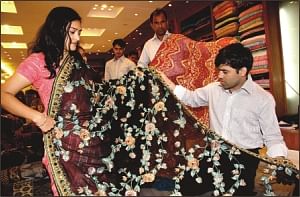Craze for Indian clothes

A woman tries on a sari at the upmarket Star World on Gulshan Avenue as shopping gathers momentum ahead of the Eid.Photo: Amran Hossain
With a gorgeous function, Star World joined last week the race of showcasing foreign-branded clothing, especially Indian wears, on Gulshan Avenue, an upmarket area in Dhaka.
Bollywood actor Mahima Chowdhury stole the exclusive fashion house's inaugural, attended among others by Dhallywood star Alamgir, legendary vocal artiste Runa Laila, songster Shuvro Dev and Aankhi Alamgir.
The new business house offers well-off customers the neighbouring country's clothes, ranging from children's dresses to wedding attires with magnificent colour and designs, which have created a craze among the Eid shoppers, especially youngsters.
Cashing in on the craze, which is said to have stemmed from Indian satellite culture, several other fashion houses or stores sprang up in the area. If you wander across Gulshan, others like Star World will not spare your eyes. You can name Shoppers World, Vasavi, Khan Brothers, Almas Super Shop, Rupali and Priyo.
The houses also import a huge number of Indian garment and other fashionable items for men, women and children to make a brisk business ahead of the Eid.
What not available here? The items include sari, salwar kamiz, wedding sari, lehanga, punjabi, pajama, serwani, shirt, T-shirt, trousers, suit, children clothes, shoes, slippers and cosmetics. The prices of those range from Tk 500 to over Tk 1 lakh.
Industry insiders say demand for such clothes have been on the rise since the late 90s. The most common thinking behind it is the influence of Indian satellite television channels. The attraction of Hindi serials and musical programmes has gripped many Bangladeshis, particularly the teens.
They now tend to imitate everything Indian. Whenever they see a new design or a new collection of sari or salwar kamiz or punjabi on Indian TV channels, they rush to the malls to buy the garment.
Local shopping mall owners say Indian clothes are more fashionable than local ones.
Star World's Sales and Purchase Manager Joynal Abedin thinks in line with the sub-continental tradition and culture, Indian clothes are world-class.
“As demand for designed clothes grows among the middle class to upper class, we have started the new mall to cater to the need of our customers,” he told The Daily Star.
Prices of the clothes in the mall that sits on a space of 8,000 square feet, ranged between Tk 700 and Tk 35,000. Other products such as shoes, slippers and cosmetics, imported from India, are also available here.
Star World also imports garments, especially for men, from Bangkok, Dubai, London and some other places, Abedin added.
“I come to buy the latest clothes and other exclusive collections here, as those are offered at a reasonable price,” said Umme Salma, a housewife who came to the Star World along with her kid on Tuesday noon to choose a pair of sandals for her daughter.
She also desired to buy a sari, as she is fond of Indian saris for its design and exclusiveness.
Echoing her, another customer searching for a sari, finds that choice options are many in the case of Indian garment items. “A fashion-conscious person will find various collections of one item, which may not be possible in the case of Bangladeshi items,” she says.
Nazir Hossain, manager of Khan Brothers, has made a point behind the fondness of Indian clothes by Bangladeshi customers.
He says almost all the Indian clothes are manufactured with synthetic fabric, while Bangladeshi items are mostly manufactured with cotton fabric.
“The design and colour reflection in synthetic fabric is much more eye-catching than in cotton fabric,” he says.
Nazir blamed the lack of development in the country's fashion and designing industry. “In India the fashion and designing industry is developed, even they do research on fashion and design regularly, whereas Bangladesh is far from such initiatives,” he pointed out.
“It's an open market economy and the fashion and design is changing every day. If Bangladesh could not cope with fashion and design, a tough time ahead for the local garment industry,” he added.

 For all latest news, follow The Daily Star's Google News channel.
For all latest news, follow The Daily Star's Google News channel. 



Comments